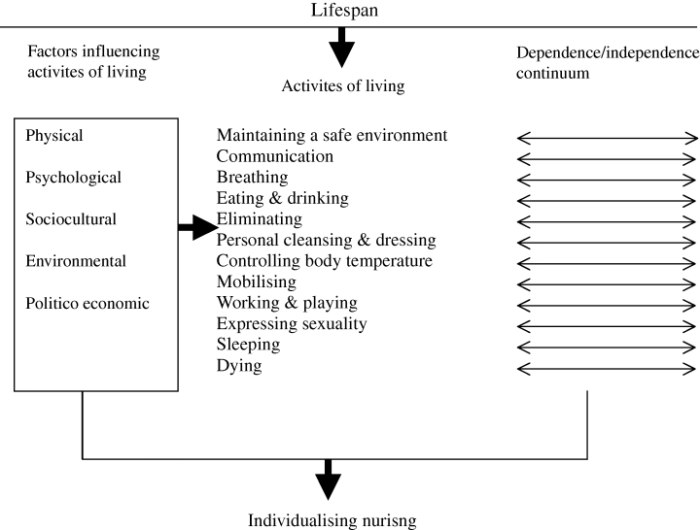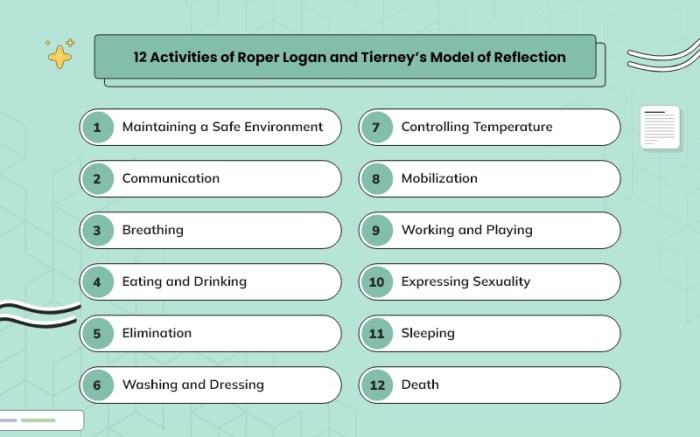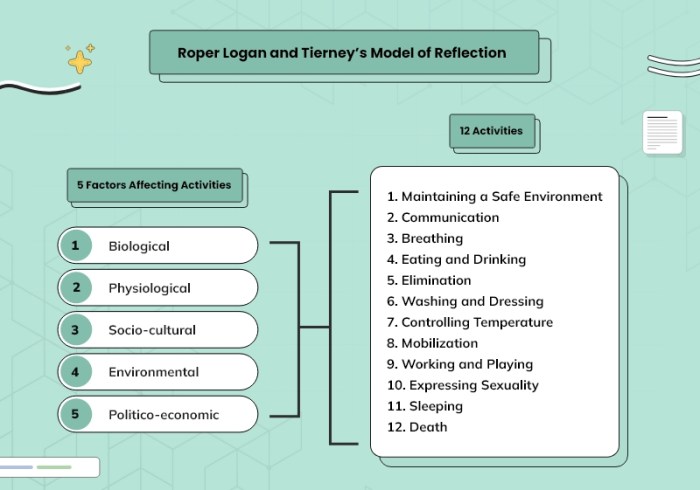The Roper Logan and Tierney Model takes center stage as we delve into its significance in healthcare. This comprehensive framework provides a holistic understanding of an individual’s functional abilities, encompassing daily living, self-care, and more. Join us as we explore the intricacies of this model and its practical applications.
The model’s multifaceted components, assessment tools, and diverse applications will be thoroughly examined, offering a comprehensive overview of its role in healthcare settings. We will also compare it to other similar models, highlighting its unique strengths and limitations.
Introduction to the Roper Logan and Tierney Model

The Roper Logan and Tierney Model, also known as the Activities of Daily Living (ADL) model, is a nursing theory developed in the 1970s by Nancy Roper, Winifred Logan, and Alison Tierney. This model provides a framework for understanding the activities of daily living that are essential for maintaining health and well-being, and it guides nurses in providing holistic care that addresses the physical, psychological, social, and spiritual needs of patients.
The Roper Logan and Tierney model emphasizes the importance of contextual understanding in reading comprehension. For practice and reinforcement, consider using the Reading Explorer 4 Answer Key . This resource provides detailed solutions to exercises that align with the Roper Logan and Tierney model’s principles, further enhancing your understanding of text analysis and interpretation.
The key concepts of the Roper Logan and Tierney Model include:
- Activities of Daily Living (ADLs):These are the basic activities that people need to perform independently to maintain their health and well-being. ADLs include activities such as eating, bathing, dressing, toileting, and mobility.
- Factors that Influence ADLs:These are the factors that can affect a person’s ability to perform ADLs. Factors that influence ADLs include age, illness, disability, and environmental factors.
- Nursing Interventions:These are the actions that nurses can take to help patients perform ADLs. Nursing interventions can include providing assistance with ADLs, teaching patients how to perform ADLs, and modifying the environment to make it easier for patients to perform ADLs.
Components of the Roper Logan and Tierney Model

The Roper Logan and Tierney Model of Nursing is a framework for understanding the activities of daily living (ADLs), instrumental activities of daily living (IADLs), and self-care that are essential for maintaining health and well-being.
The model identifies 12 components, each of which represents a specific aspect of daily living. These components are:
- Maintaining a safe environment
- Communicating
- Mobilizing
- Eating and drinking
- Eliminating
- Dressing and grooming
- Sleeping
- Working and playing
- Learning
- Participating in religious and spiritual activities
- Expressing sexuality
li>Thermoregulation
These components are interrelated and interdependent, and they all contribute to an individual’s overall health and well-being. For example, maintaining a safe environment is essential for preventing accidents and injuries, while communicating is essential for building relationships and accessing resources.
Mobilizing is essential for getting around and participating in activities, while eating and drinking are essential for maintaining nutrition and hydration.
The Roper Logan and Tierney Model can be used to assess an individual’s functional abilities and to identify areas where they may need assistance. It can also be used to develop care plans that are tailored to the individual’s specific needs.
Relationship between Components and Health and Well-being
The relationship between the components of the Roper Logan and Tierney Model and health and well-being is complex and multifaceted. However, it is clear that these components are all essential for maintaining a healthy and fulfilling life.
When an individual is able to perform all of the components of daily living independently, they are more likely to be healthy and well-adjusted. However, when an individual is unable to perform one or more of these components, they may experience a decline in their health and well-being.
For example, an individual who is unable to maintain a safe environment may be at risk for accidents and injuries. An individual who is unable to communicate may be unable to access resources and support. An individual who is unable to mobilize may be unable to participate in activities and social events.
The Roper Logan and Tierney Model can be used to identify individuals who are at risk for a decline in their health and well-being. It can also be used to develop interventions that can help individuals to maintain their independence and to improve their quality of life.
Assessment and Measurement

The Roper Logan and Tierney model provides a framework for assessing and measuring the functional abilities of individuals. It is used to identify areas of strength and weakness, and to develop individualized plans of care.
The model includes a number of assessment tools and techniques that can be used to gather information about an individual’s functional abilities. These tools include:
Observation
Observation is a key component of the assessment process. It allows the assessor to observe the individual’s behavior and interactions with others. Observation can be used to assess a variety of functional abilities, including:
- Gross motor skills
- Fine motor skills
- Communication skills
- Social skills
Interviews
Interviews are another important assessment tool. Interviews can be used to gather information about an individual’s history, current situation, and goals. Interviews can also be used to assess an individual’s cognitive abilities, such as memory, attention, and problem-solving.
Standardized Tests
Standardized tests are another assessment tool that can be used to measure an individual’s functional abilities. Standardized tests are designed to measure specific skills or abilities, such as intelligence, academic achievement, or physical fitness.
Applications of the Roper Logan and Tierney Model

The Roper Logan and Tierney Model has found wide applications in various healthcare settings, including hospitals, clinics, and long-term care facilities. Its comprehensive approach to patient care enables healthcare professionals to provide holistic and individualized care plans.
In hospitals, the model is used to assess patients’ needs upon admission, develop personalized care plans, and monitor their progress throughout their stay. It helps identify potential risks, prevent complications, and ensure a smooth transition back to the community.
Long-Term Care Facilities, Roper logan and tierney model
In long-term care facilities, the model is employed to assess residents’ functional abilities, cognitive status, and psychosocial well-being. It assists in creating individualized care plans that promote independence, maintain dignity, and enhance quality of life.
Benefits of using the Roper Logan and Tierney Model:
- Provides a comprehensive framework for assessing patient needs.
- Facilitates individualized care planning.
- Improves communication and collaboration among healthcare professionals.
- Enhances patient outcomes and satisfaction.
Limitations of using the Roper Logan and Tierney Model:
- Can be time-consuming to implement, especially in busy healthcare settings.
- Requires skilled and experienced healthcare professionals to interpret and use the model effectively.
- May not be suitable for all patient populations, such as those with acute or critical conditions.
Comparison to Other Models
The Roper Logan and Tierney Model shares similarities with other models that assess functional status, such as the Barthel Index and the Katz Index of Independence in Activities of Daily Living. However, it also possesses unique strengths and weaknesses.
Barthel Index
The Barthel Index is a widely used measure of functional independence in activities of daily living. It consists of ten items, each of which is scored on a scale of 0 to 4. The total score ranges from 0 to 100, with higher scores indicating greater independence.
The Barthel Index is similar to the Roper Logan and Tierney Model in that it assesses a range of activities, including self-care, mobility, and social interaction. However, the Barthel Index does not include any items that assess cognitive function, which is a key component of the Roper Logan and Tierney Model.
Katz Index of Independence in Activities of Daily Living
The Katz Index of Independence in Activities of Daily Living is another commonly used measure of functional status. It consists of six items, each of which is scored on a scale of 0 to 2. The total score ranges from 0 to 12, with higher scores indicating greater independence.
The Katz Index is similar to the Roper Logan and Tierney Model in that it assesses a range of activities, including self-care, mobility, and social interaction. However, the Katz Index does not include any items that assess cognitive function or psychological well-being, which are both key components of the Roper Logan and Tierney Model.
Current Research and Future Directions
The Roper Logan and Tierney model continues to be a subject of active research and development. Researchers are exploring new ways to apply the model to different populations and settings, and to refine its measurement tools.
Emerging Trends
One emerging trend in Roper Logan and Tierney research is the use of the model to assess the health of vulnerable populations. Researchers are using the model to identify the factors that contribute to health disparities among different groups, such as racial and ethnic minorities, LGBTQ+ individuals, and people with disabilities.Another
emerging trend is the use of the model to develop interventions to improve health outcomes. Researchers are using the model to identify the modifiable factors that can be targeted by interventions to improve health.
Potential Future Directions
The Roper Logan and Tierney model is a valuable tool for understanding the factors that contribute to health and well-being. As research continues to refine the model and its measurement tools, it is likely to become an even more powerful tool for improving health outcomes.Some
potential future directions for the model’s development and application include:
- Developing new measurement tools to assess the model’s constructs more accurately.
- Conducting longitudinal studies to track the effects of interventions based on the model.
- Using the model to develop new interventions to improve health outcomes.
- Applying the model to different populations and settings to better understand the factors that contribute to health and well-being.
FAQ Section: Roper Logan And Tierney Model
What is the purpose of the Roper Logan and Tierney Model?
The Roper Logan and Tierney Model is a framework for assessing an individual’s functional abilities in various aspects of daily living, self-care, and mobility.
How is the model used in healthcare settings?
The model is widely used in hospitals, clinics, and long-term care facilities to assess patients’ functional abilities, plan interventions, and monitor progress.
What are the limitations of the Roper Logan and Tierney Model?
While the model provides a comprehensive assessment, it may not be sensitive enough to detect subtle changes in functional abilities over time.